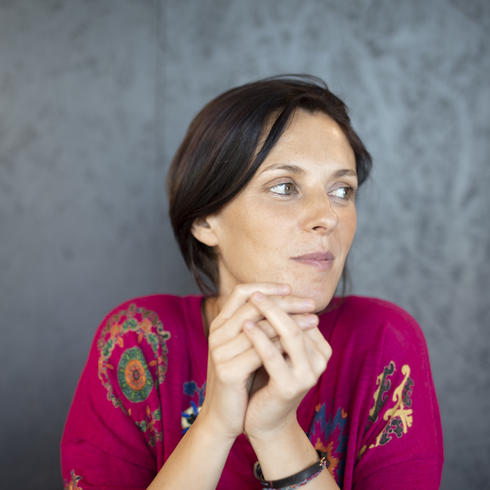
" Songs and voices "
Publication : Casa Ricordi
2024 SELECTION
- Nominated for : The Musical Composition Prize 2024
In the work for electric ensemble "Five Songs (Kafka's sirens)", written for CBarré, the title alludes - but this is not a literal reference - to Franz Kafka's story "Le silence des sirènes" (The silence of the sirens).
In reality, Kafka's story is not so much about telling an alternative history (who would say the sirens did not sing) as it is about suggesting a paradox, insinuating a doubt of perspective.
Rather, it is this - a possible paradoxical perspective - that the title alludes to. It is a form articulated in five instrumental "songs" in which the poetic question that imposed itself on me was: what is left of singing when the voice disappears?
What is the essence of singing, and how can we perceive singing when no one is singing?
This presence of singing in the absence of a singing voice was the driving force behind instrumental sound research, a kind of aporia that - like Kafka's paradox - aimed to push back the limits of the instrumental "visible".
This first question naturally calls for a question that is in some ways the opposite: what is the voice without the song? The voice for its pure presence, devoid of its orphic function? The voice as an instrumental body, and as a body in itself, the voice as a carnal presence that precedes and surpasses speech. A kind of apotropaic object that we would know without understanding.
Exploring this other half of the question prompted me to integrate a vocal ensemble into this musical journey, which thus takes place between these two extremes. Extreme absence and extreme presence, the song in the voice and the voice without the song.
Between these two focal points of paradox lies perhaps what attracts Ulysses so much to approach the sirens.
This journey is structured in several moments that explore different aspects of the voice as a body, the voice as an instrumental body, the voice as a song that inhabits the body and precedes speech, and the voice that, by embodying speech, transforms it, cancels it out and goes beyond it. All this is transparent in the myth of the sirens, as Kafka points out.
The piece is articulated - without it being in any way a question of movements - in several moments that are anchored in different aspects of these liminal states, of which the sirens are a symbol:
- Five songs (Kafka's sirens), five voiceless songs
- Voices. Where the voice is present as a body, before being song and before being speech. A body that buries itself in the body of sound to transform and rewrite it. We are here
before the text. There is a perceptive experience of vocal sound whose vocality would be forgotten or presaged: the experience of its corporeality through its occupation and sciamanic transformation of musical sound.
- Unvoiced. The so-called “unvoiced” consonants are those that do not need vocal cord vibrations to produce sound. This noisy part of the vocal emission enables articulation, and articulation is articulated time. This part takes place in a musical state of "pure time", where the voice inhabits and is itself a prisoner of purely temporal writing.
- A valediction for her sister (a love song). This moment is a song in the truest sense of the term. It is a love song for voice and acoustic guitar only. The guitar has a particular scordatura that brings it closer to the lute, and the vocal harmonic space is a non-tempered (just) microtonal space. The text used here is a very old song in griko (a language born of the hybridisation of ancient Greek with the native languages of Salento), collected in Corigliano. The anonymous folk text is still in a poetic "place" that precedes that of the poetic self. In these texts, only birth, love and death are sung, and there are always several versions of the same text, as is often the case with anonymous folk songs. It is a poetry that has not yet been separated from the bodies. Here is the text in Griko and Italian:
Aspron e' to chartì, aspro e' to chioni,
aspron e' to chaladzi, aspri ine i krini,
aspro to sfondilòssu ce i vrachoni,
c'echi is o' petto dio mila afse asimi.
Isèa se kaman dio mastoroni
ce se pingéfsane i aji serafini;
ce se pingefsan ce se kaman òria,
pu 'e s'echi de' is in ghì manku is in gloria.
Bianca è la carta ed è bianca la neve,
bianca è la grandine e son bianchi i gigli,
bianco il tuo collo e bianche le tue braccia,
poggiate al petto due mele d'argento.
Ti hanno pensata due grandi pittori,
ti hanno dipinta due santi serafini;
ti hanno dipinta e ti hanno fatta bella,
e non c'è uguale in cielo e sulla terra.
- Vocali. Here, the instrument spectrum is associated with the spectrum formed by the modification of the oral cavity through the production of vocal sounds (vowels), and with the multiphonics obtained by hybridising the voice with mouth harmonicas.
- Andemironnai (a song of migration). Andemironnai or Iandemironnai is a refrain that forms the stanzas of a traditional Sardinian song, whose lyrics are as follows: "Iandemironnai andire nora ndira iandemironnai".
"Many people trace the song (whose lyrics are incomprehensible today) back to very ancient times, perhaps to the time of the mythical and very archaic Nora, a pre-nuragic city now submerged.
The obscure refrain, with its term is vaguely reminiscent of the "comings and goings" and its "nora" voice, which is certainly protosardic, sounds very old.
It is possible (if you listen to your imagination) that the refrain uses the word Nora to express regret for a lost homeland: the town of Nora, an ancient Phoenician port of call (editor's note: Carta Raspi traces it back to the Shardana, but it could be much older), then a Punic centre and later a flourishing Roman city that retained to the end the pride of being the mother town of all other Sardinian cities. In Roman times, it helds a rank of honour equal to that of Kàralis. Its remains (temples, necropolises, quays, Roman port buildings, basilicas, etc.) were devastated by the action of earthquakes and the sea. Destroyed by Vandal invasions, Nora was never reborn.
These are therefore words whose verbal meaning has been lost, but which retain this function of migratory movement towards the unknown, or song of passage in the song that still embodies it today." (1)
It is a polyphony of polyrhythmic and microtonal structures, where the instrumental writing thickens to the point of saturating the space. We explore the concept of limits and temporal illusion. Movement is inevitable, and inevitably pushes us into the unknown. The very idea of migration and passage is strongly inscribed in the myth of the sirens. We
return to the sirens as an image of the limit of song and sound itself (Kafka's sirens owe their horror to their silence, which could have broken even Ulysses' resistance).
The sirens are always at a crucial point that marks a decisive passage. Passage between the living and the dead, passage between the known and the unknown (among other things).
Indeed, "the myth of the sirens also served, among other functions, to enable a discourse on space, and in particular on the notions of limit, border and margin. These categories are both analogous and different in their various meanings: the boundary is the place where something ends, but also where something begins, making reality measurable and therefore meaningful; the frontier, on the other hand, presupposes a division, but also a relation between the same and the different, between the self and the stranger. And this is precisely where the category of the margin comes in, defining what is neither on this side nor on the other of the border, the no man's land, the place of passage, of transformation." (2)
This work is a musical "tomb", a funerary monument, an attempt to pay humble homage to the memory of my sister, who died prematurely in tragic circumstances. So, while A valediction for her sister for voice and guitar in scordatura is a love song, the whiteness of the snow, the paper and the girl's skin are equally reminiscent of a lifeless body.

